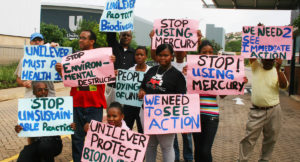There are plenty of hurdles when campaigning to get large multinational corporations to change environmentally damaging practices.
For palm oil campaigners, those obstacles include complexity and relevance. Dozens of players – corporations, local and national governments, NGOs, and intergovernmental – are involved in creating, managing and regulating production and supply. And palm oil forests are far from the public eye – and also far from store shelves where palm oil products end up. Keeping activists engaged in complex, remote campaigns is challenging.
But what if you can take the action to a “store” that’s right there in your audience’s hand – one that offers a place for conversation, photos and personal stories?

A user-submitted image added to a Pepsi True review at Amazon.com.
That’s what Gabe Smalley at Rainforest Action Network (RAN) and Hanna Thomas at SumOfUs did (along with their campaign and digital teams) when they launched a campaign on a PepsiCo product page at Amazon.com.
On November 19, 2014, RAN and SumOfUs took the campaign to Amazon by asking supporters to “review” Pepsi True, a new PepsiCo beverage marketed as a “healthy” soda that was being sold exclusively on Amazon.
By the end of the day, Pepsi True had received over 1,500 reviews averaging one star and the product had temporarily disappeared from Amazon. The story quickly generated media attention in the UK and elsewhere.

Screenshot of the Pepsi True product page and questions asked by reviewers. Both screenshots were taken the day after the campaign launched.
We talked to Gabe Smalley and Hanna Thomas about the Amazon review approach, the ongoing campaign and efforts to engage citizens and build support in the Conflict Palm Oil campaign.
There’s No Hiding in Online Reviews
The Amazon product review effort grew out of a series of online and on the ground actions in mid-2014. “We knew we needed something new and a bit different to engage our list while delivering campaign results,” said RAN’s Gabe Smalley. “We brainstormed areas where we could throw a punch Pepsi wouldn’t see coming.”
Amazon Reviews Call Out Amazon
In late-September, 2014, Greenpeace campaigners used Amazon reviews to challenge Amazon’s own practices, namely its use of fossil-fuel powered data centers.
As part of a broader campaign to get Amazon to commit to 100% renewable energy sources, organisers asked people with Amazon.com accounts to criticize Amazon’s energy policies in reviews of the Amazon Fire phone. Hundreds (likely thousands) responded with one star critiques.

A snapshot of over 4,300 Amazon Fire reviews (2 1/2 stars) in January, 2015.
In mid-November, 2014, Amazon announced its long-term commitment to 100% renewable energy usage for its global infrastructure. Certainly a step in the right direction that may have been guided, in part, by thousands of people voicing their disappointment with Amazon on its own turf.
Find out more in Wired and read the email Greenpeace campaigners sent to activists about the Amazon Fire phone.
SumOfUs pitched in with brainstorming when a campaign manager noticed that Pepsi True was launching exclusively on Amazon. Taking on PepsiCo through Amazon created a lot of excitement with RAN activists, and SumOfUs provided a strong boost by emailing their list to get involved.
Both teams have campaigned this year on PepsiCo’s palm oil practices. PepsiCo’s global digital strategy is well regarded and they’re investing heavily in it. Meanwhile, RAN this year has organised supporters to take over the #LiveForNow hashtag and visit Pepsi-sponsored events.
“Our mantra all summer has been to hit Pepsi where it can’t hide. Petitions and emails only get you so far, so we’ve moved our campaign forward into the online space that Pepsi considers their space. What makes Amazon an even stronger target was that this was the exclusive launch site for Pepsi’s new product, and they were leaning heavily on it. Pulling it down monkey wrenches their entire marketing strategy, and leaving it up means that they can’t hide from the reviews. It’s a tactic that leaves Pepsi without any good options.”
– Gabe Smalley, Rainforest Action Network
Amazon is also, for now, the only place Pepsi True is sold. “It seemed like an easy way to target [PepsiCo’s] only sales channel for Pepsi True and threaten the product’s profitability, as well as provide an opportunity for our members to communicate directly with PepsiCo and give them feedback on their current palm oil policy,” said Hanna Thomas.
Developing Higher Engagement (and Measuring It, Too)
Writing comments on a company’s Amazon page based on an email ask is no small task. It is, to be precise, simple to ignore and easy to not follow through on.
We asked both groups about how they segment supporters and if they engaged certain groups of supporters in this action. RAN viewed the Amazon campaign as a good test for their higher level activists — would this be something they see as a good use of time and connected to the campaign.
RAN’s Smalley told us that they have “…a group of hardcore online activists who we’ve invited to step up their online game. These folks have opted into a higher level of communication and higher bar online actions that go beyond signing a petition.” RAN sent a detailed email to this group and they believe their activists jumped on it fast. Commenting on this group of activists, Smalley said “I’ve seen them really step up and own the campaign material. Their authenticity and enthusiasm makes this and other online actions very real for target companies.”
There are a couple thousand reviews of the Pepsi True product, most coming the first day or two, and it’s difficult to tell which activists heard about it from RAN and which were sent by SumOfUs.
This is one example of how difficult it can be to get solid metrics from an online action. Sure, we know (very quickly) how many emails were sent, how many links were clicked and who clicked them. These measurements are helpful but don’t give us much insight into what motivates an activist to take deeper actions, if they’ll take actions again or if those actions helped.
Earlier this year, SumOfUs shared a set of metrics its calling MeRA, short for Members Returning for Action. The MeRA unit of measurement is the number of unique members who have taken an action other than their first one. SumOfUs campaigns metrics include a 30-Day MeRA, Monthly MeRA and Source Monthly MeRA. What does MeRA look like in use? Hanna Thomas told us that of all people who joined SumOfUs on a PepsiCo palm oil petition in April, 2014, 43% have taken action on another campaign in the past month. The MeRA metric is giving SumOfUs useful insight into its work to keep palm oil activists (and others) engaged which saves the organization recruitment costs, builds the list and creates experience among activists.
Power of the Crowd Drives Results
To varying degrees, companies rely on public goodwill and positive word of mouth. But ecommerce sites such as Amazon (and especially Amazon) centralizing purchasing decisions and its product reviews and Q&A forums concentrate public feedback and visibility of that feedback. The same could be said for Yelp, TripAdvisor and any number of online commerce and review sites around the globe.
If an ecommerce or review site is key to a business model then organising that community (and your own) can be effective. As Hanna Thomas of SumOfUs told us about PepsiCo’s initial response, “When it threatens their business model – [and] this is the only avenue where Pepsi True is getting sold, it’s very important for PepsiCo. They panicked.”
Taking action in an Amazon review creates a campaign moment but the impact on a company can linger as reviews stay on the site. Even today, four weeks later, PepsiTrue has over 4,000 reviews and a one star rating.

Three weeks after launching, Pepsi True had a one-star rating among over 4,000 reviewers.
For both RAN and SumOfUs, the Amazon action was one test in a long effort to publicly pressure PepsiCo and others to change palm oil practices. RAN held a call-in day on December 9. The Amazon action gave RAN activists that couldn’t (or wouldn’t) call an opportunity. “Some folks are comfortable with a computer, some are comfortable with phones, some want to organize in their communities as part of our Palm Oil Action Team. We are looking for [many different] ways to empower them to get engaged on the campaign,” Smalley told us.
We asked RAN’s Smalley about the ongoing potential for using e-commerce venues such as Amazon to both engage the public and pressure targets. Smalley told us “it’s time that we as advocacy groups take a stronger stance in the online space that companies deem ‘theirs.’ This type of tactic, for Amazon or other sites, seems to work best when companies forget that they’re operating in a space that they can’t control.”
This would apply to Twitter and other online spaces built for real-time interaction. Well-organised advocates can seize the conversation and be forced to transparently engage (or transparently ignore) the public.
This story was updated on January 12, 2015, to share results of a Greenpeace campaign that asked people to promote renewable energy use by Amazon in the Amazon reviews of the Amazon Fire phone.
Stay Involved
Categories:
tech, tools and tactics



